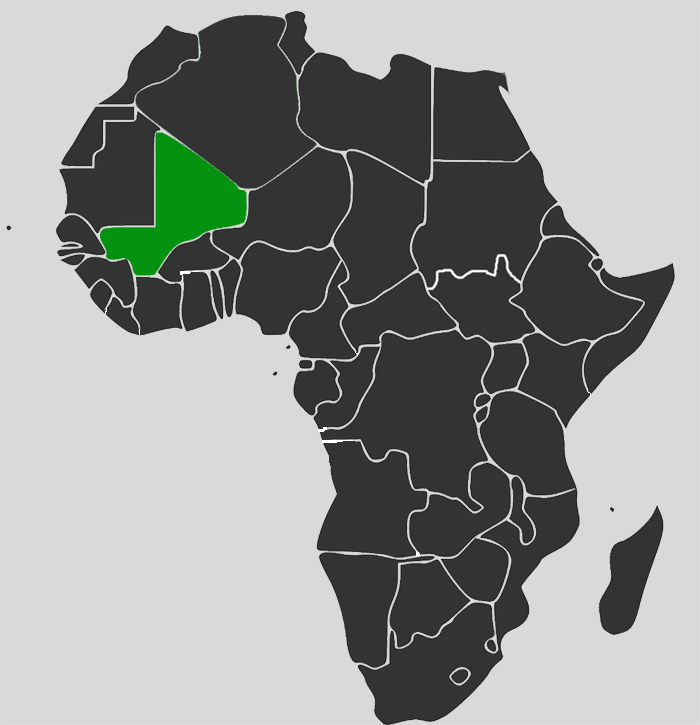Republic of Mali
Total Population
19.6 million
Deaf Population
40,000-65,000
Nation's Official Language
French
Other Languages
The number of established languages listed in Ethnologue is 68. Some of these are:
- Arabic, Hasanya
- Bamanankan
- Bomu
- Bozo
- Dogon
- Duungooma
- Fulfulde
- Jula
- Kagoro
- Siamou
- Songhay
- Soninke
Name of Sign Language
Langue des Signes Malienne (LSM), Langue des Signes de l´Afrique Francophone (LSAF)
Overview Of Deaf Community And Education
Deaf education in Mali was established relatively late in comparison to the adjacent countries. The first deaf school, the Ecole pour les Déficients Auditifs (EDA), was established in Bamako, Mali’s capital, in 1993 by the Malian teacher Bala Keita. A year later, a second deaf school was opened by Canadian sign linguist Dominique Pinsonneault. Since then, schools and units integrated in mainstream schools were opened in various places. In 2002, deaf director Dramane Diabaté opened a deaf school in Kita.
Around the same time, a group of parents of deaf children initiated the opening of a deaf school in Goundam, near Timbouctou. Around 2008, more schools were opened in Sikasso, Koutiala, and Ségou. A unit for deaf children was open in Douentza in 2012. The total number of educational centers for deaf children in Mali thus seems to be eight. This is obviously not enough to cater for all the deaf children across the country. Reportedly, occasionally deaf children are sent to France for deaf education.
The EDA school also trains former deaf pupils and people from neighboring countries to become deaf school teachers. The EDA school also hosts the meetings of the deaf association AMASOURDS, which is currently headed by a Gallaudet alumnus. Dupont (2007) presents an extensive description of the EDA school. Around 2001, both schools switched to the ASL-based Langue des Signes de l’Afrique Francophone, in line with the policy in the surrounding French-speaking countries.
From their onset, the deaf schools in Mali have favoured the use of signing as a means of communication in education. For a brief period, the EDA school experimented a bilingual approach integrating both deaf and hearing children. However, this experiment was considered unsuccessful and was ended. Originally, the locally evolved Malian Sign Language was used in the first two schools for the deaf.
As in many African countries, Reverend Andrew Foster and the Christian Mission of the Deaf (CMD) was involved in setting up deaf education in Mali too, in the 1980s. Although he did not succeed in this attempt, he did succeed in training three deaf Malians in the CMD training center in Ibadan, Nigeria. Two of them later worked as teachers at the EDA school, and two became active board members of the deaf association.
Occasionally, sign language classes are taught for parents by Association Malienne pour les Sourds (AMASOURDS). There is no sign language teaching or research at university-level. There is no systematic government support for sign language related activities..
Sign Language Overview
Various sign languages are in use in Mali. In the deaf schools, a Malian variety of the Langue des Signes de l’Afrique Francophone (LSAF) is used. This variety has not been documented or studied by linguists. In the deaf schools, several vocabularies are available for LSAF, including those developed locally and those developed in other French-speaking countries in West Africa.
Malian Sign Language, as used by older deaf people in Bamako, spontaneously emerged in this city prior to the establishment of deaf education. As mentioned above, this sign language was initially used in the first two schools for the deaf. In 1995, a trilingual dictionary was published for the Bamako variety of Malian Sign Language by Pinsonneault, containing around 500 signs. In 2012, an annotated video corpus of Malian Sign Language as used in Bamako was published, following a large scale documentation project. There is quite regular interaction between the deaf community in Bamako and other urban centres in Mali, such as Mopti, Ségou, and Kita. As a result, there seems to be considerable overlap in the signing in these places.
From 2012-2016, a documentation project was done on the signing of deaf people in the area around Bandiagara and Douentza, again resulting in an annotated video corpus of the varieties encountered based on recordings of deaf signers. There are notable differences in lexicon with the Bamako variety. Various villages around Douentza have a higher incidence of deafness, mainly as a result of meningitis and hereditary deafness. There seems to be regular contact between the deaf people in the villages and deaf people living in Douentza. As a result, there notable lexical similarities between their varieties, such as the terms used to denote colors.
A family sign language which had independently evolved was found in the village of Berbey. For a more extensive report of deaf signers and signing in and around Douentza and in Berbey.
Deaf Organizations In Country
- Association Malienne pour les Sourds (AMASOURDS)
Overview of Interpreting Services
Interpreting services are a major challenge in Mali, with few interpreters and no formal training for them. Bala Keita, director of the first school for the deaf, is providing interpretation of the news on television.
Resources
Nyst, V., K. Sylla and M. Magassouba. 2012. Deaf signers in the Dogon, a rural area in Mali. In Sign languages in village communities: Anthropological and linguistic insights, eds. U. Zeshan and C. de Vos, 251-276. Sign Language Typology Series 4. Berlin: Mouton de Gruyter.
Dupont, E. (2007) Bobo in Bamako. Deaf Community: Hippodrome’s LÉcole pour des Deficients Auditifs. Unpublished paper. School for International Training.
Nyst, Victoria (2015) The Sign Language Situation in Mali. Sign Language Studies Vol. 15, No. 2 (Winter 2015), pp. 126-150
Pinsonneault, D. (1999) Lexique des signes utilisées par les sourds au Mali. Mali: Editions Donniya.
List of Contributors
Victoria Nyst



